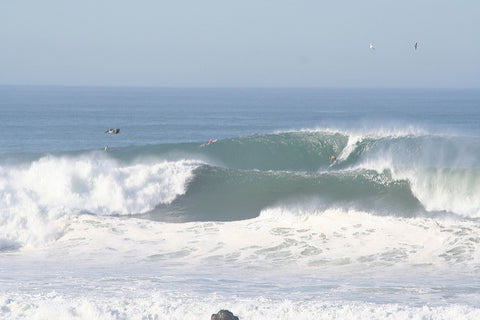3 Things To Check Online Before Going Surfing
3 things to check before you go surfing
“How do I know when the surf is going to be any good?” is probably the first question many people ask following an introductory lesson. After having a great time catching your first few waves and maybe standing up once or twice, its natural to want to know when is the best time to go again.

Good surf for some......but maybe not after your first lesson
As with the weather in Ireland, the answer to the question is surprisingly complex and if you don’t do your homework before you go it wont be nearly as good as if you did.
The first thing you have to do is define what you mean by “good”. If it’s before or after your first lesson or two then the definition of “good surf” is going to be a lot different than someone who has spent the last 5 winters on the north shore of Hawaii.
For a beginner your much better off with 1 to 2ft crumbly waist high waves than the kind of surf you might see the pros out in.
Below we have listed 3 things to always check before you go surfing to be sure you never waste a trip to the beach.
1.The Wind
For the best surfing conditions possible, the general rule is “offshore (wind blowing from land to sea) wind is good, onshore (sea to land) wind is bad. However this is not always true.
Experienced surfers tend to seek offshore wind for its ability to make waves bigger and stay open longer due to it blowing back against the face of the breaking wave. While ideal for surfing when you’re more experienced, this kind of wind can also be dangerous if you are a complete beginner.
A strong offshore wind will tend to create, or intensify; rip currents moving out to sea and an unwary beginner could end up like this guy in japan who spent 16 hours at sea after getting caught in a rip!
The same theory applies to onshore wind. While a strong onshore wind can completely ruin the surf, a light onshore doesn't make much difference to the waves and might even be the most ideal kind of wind for a not so experienced surfer as it makes the surf more forgiving.
To check the wind conditions for Tramore keep an eye on windguru and or Magicseaweed and remember for Tramore beach a northerly wind is offshore and southerly wind is onshore. Look out for days with wind speeds of <20km in either direction (or better yet barely any wind at all) and your good to go!
2.The Swell
Swell is the name for the open ocean energy which, when it enters shallow water near the shoreline and tumbles over itself (more on this another time), breaks and makes the waves we surf. So, based on the fact that swell=waves, you could say the more swell the better! While that might seem like an obvious thing to want its only true up to a point.
For most shallow, beginner friendly beaches in Ireland, like Tramore, a swell of more than 6ft (2 metres) with a period (length between waves measured in seconds) of more than 9 seconds or so will likely equal a messed up un surfable mush that is particularly bad for beginners.
While some reefs, point breaks and steeper beaches will hold a far larger swell and create excellent conditions for intermediate and advanced surfers with big waves, for beginners and learners you really don’t want a swell bigger than 6ft or so on a beach like Tramore. A far more idea swell height is between 1 and 4ft which will create a waist to head high waves when it breaks on the beach.
To check the swell, your best bet again is to look at Magicseaweed or windguru or better again check out Met Eireanns buoy reports and see what the reading is for the M5 buoy (moored just off the south coast) to get a live update.
3.The Tide
The state of the tide can make a big difference to any surf spot. Gentle rolling waves on a beach at low tide can turn into a dangerous shore break at high tide just because the waves have less sand to go over before they get to the shoreline.
The ideal tide for your local surf spot will vary hugely but generally for beginners, coming to a beach like Tramore especially, low or mid tide will be best. Another advantage of this is that it lets you see any rocks or hazards on the beach before they are covered by water.
You can check the tide again at Magicseaweed and remember there are 4 tides (2 low and 2 high) every day with 6 hours in between each. If you are unsure about what tide is safest at your local surf break ask a lifeguard or a local who is there often.
Remember
Before your next trip to the beach and to make sure you don’t get skunked (left with no waves) or end up washed out to sea. Check windguru and Magicseaweed for the wind, swell forecast and tide.
For Tramore beach look for a small swell(<6ft), light to moderate winds in any direction and a low to mid tide. If you're still not sure that surf is safe for your level ask a lifeguard or a more experienced surfer who knows the beach. Better yet check out our webcam or give us a call to be sure of what the surf is doing and if its good for you.
 Free Delivery Over €70
Free Delivery Over €70 See Our Reviews
See Our Reviews





16 comments to show